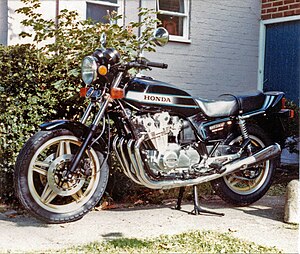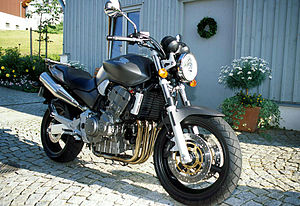Honda CB900F
 |
|
| Manufacturer | Honda |
|---|---|
| Production | 1979–1983 |
| Successor | CB1100F |
| Engine | Air-cooled 901 cc (55.0 cu in) DOHC straight-four |
| Bore / stroke | 64.5 mm × 69.0 mm (2.54 in × 2.72 in) |
| Compression ratio | 8.8:1 |
| Top speed | 190 km/h (120 mph) (1979–1981), 210 km/h (130 mph) (1982) 217 km/h (135 mph) |
| Power | 71 kW (95 hp) @ 9000 rpm |
| Torque | 7.9 kg·m (77 N·m; 57 lbf·ft) |
| Ignition type | Electronic |
| Transmission | 5-speed, chain drive |
| Frame type | Steel twin downtube |
| Suspension | Front: Air-assisted telescopic forks, Honda TRAC anti-dive system after 1982 or 1983 Rear: twin shocks with adjustable compression, damping and rebound |
| Brakes | Front: dual disc Rear: single disc Dual piston calipers on all after 1983 |
| Tires | Front: 3.25"x19" (100/90-19) Rear:4"x18" (130/80-18) |
| Rake, trail | 27° 30' 115 mm (4.5 in) |
| Wheelbase | 1,515 mm (59.6 in) |
| Dimensions |
L: 2,240 mm (88 in) W: 805 mm (31.7 in) |
| Seat height | 815 mm (32.1 in) |
| Weight | 233 kg (514 lb), 241 kg (531 lb) (after 1982), or 234 kilograms (516 lb) (dry) n/a (wet) |
| Fuel capacity | 20 l (4.4 imp gal; 5.3 US gal) |
| Related | CB750, CB900C |
 |
|
| Manufacturer | Honda |
|---|---|
| Also called | Honda Hornet 900 (Europe) Honda 919 (United States) |
| Production | 2002–2007 |
| Successor | CB1000R |
| Class | Standard |
| Engine | 919 cc (56.1 cu in) liquid-cooled straight four |
| Bore / stroke | 71.0 mm × 58.0 mm (2.80 in × 2.28 in) |
| Compression ratio | 10.8:1 |
| Top speed | 230.0 km/h (142.9 mph) 228.5 km/h (142.0 mph) |
| Power | 71.9 kW (96.4 hp) 75 kW (101 hp) @8550 rpm 77 kW (103 hp), 80 kW (110 hp) @ 9,000 rpm |
| Torque | 84.9 N·m (62.6 lbf·ft) 91 N·m (67 lbf·ft) @ 6,500 rpm 88.9 N·m (65.6 lbf·ft) @ 7550 rpm |
| Ignition type | CDI |
| Transmission | Cable-actuated wet clutch, 6 speed, chain final drive |
| Frame type | Steel, square section backbone, engine is stressed member |
| Suspension | Front: telescoping cartridge fork, adjustable after 2004 Rear: swingarm with single Showa shock, adjustable preload |
| Brakes | Front: dual disc Rear: single disc |
| Tires | Michelin Hi-Sport Front: 120/70-ZR17 Rear:180/55-ZR17 |
| Rake, trail | 25°, 98 mm (3.9 in) |
| Wheelbase | 1,460 mm (57 in) |
| Dimensions |
L: 2,125 mm (83.7 in) W: 750 mm (30 in) |
| Seat height | 795 mm (31.3 in) |
| Weight | 206.0 kg (454.2 lb) (dry) 218.0 kg (480.6 lb), 220.0 kg (485.0 lb) (wet) |
| Fuel capacity | 19 l (4.2 imp gal; 5.0 US gal) |
| Fuel consumption | 6.11 L/100 km (46.2 mpg‑imp; 38.5 mpg‑US) 6.4 L/100 km (44 mpg‑imp; 37 mpg‑US) |
| Related |
CB600F CBR900RR |
The Honda CB900F is a Honda motorcycle made in two iterations which appeared some twenty years apart. Both generations of the CB900F are straight four-cylinder four-stroke 900 cc (55 cu in) roadsters.
The first generation was produced from 1979 through 1983, and was available in the United States in 1981 and 1982. In 1983 it was replaced by the CB1100F. The second generation was available from 2002 through 2007. It is called the Hornet 900 in Europe and the 919 in North America, while the related CB600F is the Hornet 600 in Europe and the 599 in North America. In 2008 the second generation CB900 was replaced by the CB1000R.
In 1969 Honda introduced its flagship CB750 superbike, whose success led to Honda's domination of the motorcycle market. By 1978 the SOHC CB750F2 struggled to compete against more advanced DOHC fours from Kawasaki, Yamaha and Suzuki. Honda needed to reclaim its former dominance, and the company set about developing a successor. Honda had been successful in European endurance racing with their RCB-series RS1000, and had made advances in suspension technology from their experience in , and the company chose to base a new DOHC roadster on their endurance racer.
The CB900F's design was aimed at European markets, rather than the usual focus on the United States, where it was not available until 1981. In Europe, it was initially named Super Sport like the 750 (FZ and FA) later named after the Bol d'Or endurance race. In the market, the CB900F competed with larger capacity bikes like the Kawasaki Kz1000, Suzuki GS1000, and Yamaha XS1100.
...
Wikipedia
